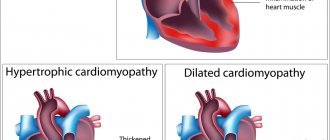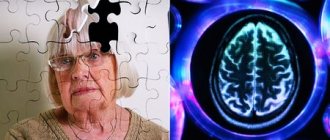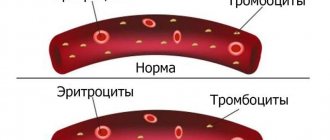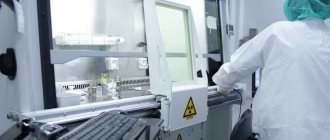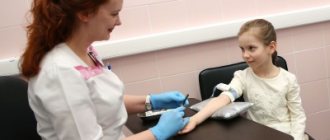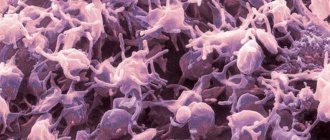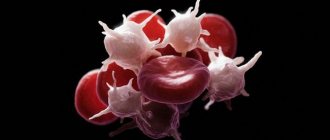Thrombocytosis is a hematological pathology characterized by an increase in the number of platelets in the blood.
The provoking factor is associated with dysfunction of bone marrow stem cells.
Such a disorder causes accelerated “production” of platelets, and becomes an obstacle to decay.
In addition, the distribution of “blood platelets” in the bloodstream, as platelets are secondarily called, changes upward. The numerical indicator for healthy hematopoiesis ranges from 200-400*109/l. A value falling below 200 indicates thrombocytopenia; an increase in values above 400 indicates thrombocytosis.
The list of tasks assigned to these blood cells:
- cellular hemostasis
- fight against blood clots - dissolving blockages
- nutrition, protection of blood vessel walls
Main factors of the disease
Colorless platelet cells are formed in the bone marrow and are an integral element of the blood. Cells do not have a nucleus; they have a round, oval shape and a smooth surface. The duration of ripening and the viability period is approximately 8 days, after which it is destroyed.
The cells have the ability to activate upon contact with a surface that differs in composition from the cells of the internal coatings of blood vessels and the heart (endothelium).
At the same time, the platelet develops processes called pseudopods, the area of which is several times larger than the size of the blood plate itself (from 5 to 10 processes are formed). When they come into contact with a foreign surface, platelet cells connect with each other, forming a blood clot.
Also, platelet cells contain substances that are necessary for the synthesis of special substances (lysocine, B-lysine) that destroy the membranes of certain types of pathogenic microorganisms.
Platelet cells also take part in the delivery of nutrients to the endothelium. An excessive number of platelets leads to increased blood thickness and many negative consequences.
Treatment of pathology in children
To treat the disease, drug therapy is used in conjunction with a special diet that helps normalize the level of flat blood cells. For drug therapy use:
Defects associated with hematopoiesis cannot be dealt with without the use of medications to reduce the number of platelets and thin the blood. It is necessary to take medications in accordance with the pediatrician’s dosage instructions.
Classification of thrombocytosis
The disease can be either independent or caused by other ailments. There are primary and secondary thrombocytosis.
- Primary type – represents a disease of the bone marrow. In 20% of cases, the consequence of primary thrombocytophilia is the replacement of bone marrow cells with fibers of collagen origin (myelofibrosis). In 2% of cases, transition to acute leukemia is possible. This type of disease occurs mainly in people over 60 years of age. The overall prognosis for the treatment of essential thrombocytosis is favorable with appropriate therapy and prevention of relapses.
- The secondary (reactive) type appears in other diseases, acting as part of the body’s defense mechanism.
Thrombocytosis in adults and children is treated by a hematologist who identifies the causes of the disease and prescribes a course of treatment together with other specialists.
Diagnostics
Platelet levels can be determined as part of a clinical (“complete”) blood test. This is usually done using automatic hematology counters.
In diseases accompanied by changes in platelet size, counting is carried out in a conventional microscopic analyzer. To receive a referral for analysis, you must first contact a physician. Subsequently, consultations with specialized specialists may be required - hematologist, surgeon, oncologist, cardiologist, immunologist.
To more accurately determine the cause of this condition, the doctor may prescribe additional tests:
- biochemical blood test to identify inflammatory markers (C-reactive protein, fibrinogen, ferritin, ESR), indicating secondary thrombocytosis, the level of lactate dehydrogenase, a significant increase in which is characteristic of malignant blood diseases;
- molecular genetic study for suspected chronic myeloid leukemia;
- trephine biopsy of bone marrow for differential diagnosis of myeloproliferative diseases;
- Abdominal ultrasound to detect changes in the liver and spleen;
- colonoscopy and FGDS to identify ulcerative lesions of the gastrointestinal tract;
- ECG and other methods of instrumental research.
Causes of the disease
The primary type of the disease is a hematological abnormality. The disease of the secondary type appears due to:
- Various infections. Provoking agents are bacteria (most often menningococci), viruses, fungi, and parasitic forms of pathogens. The disease appears during diseases of the upper and lower respiratory tract, damage to organs and systems of the gastrointestinal tract, liver, kidneys and other organs and systems.
- Inflammatory processes - in the musculoskeletal system (arthritis, arthrosis, rheumatism, other ailments), with chronic inflammation of the liver, Kawasaki syndrome, cancer and other inflammatory processes.
- Hematological reasons - basically, this reason is a lack of iron in the blood. It is typical for asthenia, with large blood losses, after operations and chemotherapy.
- Reactive thrombosis, caused by surgery on the spleen or asplenia (congenital absence of this organ). About a third of all platelets produced in the body accumulate in the spleen. With partial or complete removal of an organ, the volume of distributed blood decreases, and the number of platelet cells increases.
- Tumors of benign or malignant origin. The most dangerous are neuroblastoma, hepatoblastoma, and lymphomas.
- Drug influence - some medications cause an increase in platelet levels (corticosteroids, sympathomimetic drugs, others).
- Poisoning of the body of various etiologies.
- Injuries, bone fractures.
Manifestations of thrombocythemia
on the right - the release of an excess number of platelets into the blood in any form of thrombocytosis, (on the left - normal)
Symptoms of thrombocytosis may be absent for a long time, then the disease is discovered either by chance or when complications occur. The most typical:
- Thrombosis and thromboembolism;
- Erythromelalgia (pain in the limbs);
- Neurological disorders associated with cerebral ischemia due to thrombosis and microcirculation pathology;
- Disorders of pregnancy, miscarriages in women;
- Hemorrhagic syndrome.
Thrombosis and thromboembolism are the most characteristic signs of thrombocytosis. An excess of platelets causes increased blood clotting and the formation of blood clots in both arterial and venous vessels, but the arteries become clogged somewhat more often.
Manifestations of thrombosis can be myocardial infarction, acute cerebrovascular accident (cerebral infarction). Possible pulmonary embolism. Vascular accidents in young people are often associated precisely with thrombocytosis, which could be asymptomatic for a long time.
Erythromelalgia is another characteristic symptom of the disease, which is expressed in sharp, burning pain in the extremities, usually the feet. The pain intensifies with heat and physical activity; a feeling of heat and darkening of the skin may occur.
Thrombosis of small vessels leads to ischemic changes in soft tissues with severe pain in the fingertips, coldness and dry skin. In severe cases of pathology, thrombosis can cause complete disruption of blood flow, which is fraught with necrosis (gangrene) of the fingers and toes.
hemorrhages in DIC syndrome
Blockage of cerebral vessels by blood clots leads to a variety of neurological disorders: decreased intelligence, dizziness, focal neurological symptoms. When the retinal vessels are damaged, vision suffers.
Thrombocytosis can be very dangerous in pregnant women. In the early stages, it provokes miscarriages, in later stages – placental infarctions, developmental delay and even fetal death, complicated labor (placental abruption, massive bleeding).
Hemorrhagic syndrome occurs in half of patients with primary thrombocytosis and is associated with the development of chronic disseminated intravascular coagulation syndrome, when coagulation factors are consumed in the process of constant thrombus formation. Hemorrhagic manifestations are reduced to hemorrhages in the skin (petechiae, ecchymosis), bleeding of the gums, and gastrointestinal tract. Insufficient blood clotting poses a great danger during surgical operations due to the risk of severe bleeding.
With prolonged thrombocytosis, other symptoms may occur:
- Weakness, fever, weight loss, bone pain as a manifestation of tumor pathology (primary thrombocytosis);
- Pain in the hypochondrium due to enlargement of the liver and spleen;
- Tachycardia, pallor, shortness of breath with the development of anemia;
- Recurrent infectious diseases.
Secondary thrombocytosis does not have such characteristic manifestations as essential thrombocytosis, and the patient presents complaints related to the underlying disease. Thrombohemorrhagic manifestations are not typical, the spleen does not enlarge. Usually it is diagnosed in a timely manner and, with treatment of the underlying disease, quickly regresses without leading to blood clotting disorders.
Symptoms of the disease
At the initial stage of the disease there are almost no manifestations. Later the following symptoms appear:
- headache;
- vision is impaired;
- bleeding from the nasal cavities and bleeding gums occur;
- the appearance of blood inclusions in the stool is noted;
- General weakness and increased irritability appear.
The risk group includes:
- age category of the population over 60 years old;
- patients with iron deficiency anemia;
- cancer patients;
- those who have undergone operations, fractures and other serious injuries.
Blood thrombocytosis causes and treatment
admin page » Platelet 16354 ( 1 5.00 out of 5) Loading…
People often ask: “thrombocytosis causes and treatment” - let’s figure out what this attack is and how to deal with it. In this article you will find answers to the questions: causes, classification, symptoms and treatment of thrombocytosis.
Knowledge Base: Thrombocytosis
What is thrombocytosis? This is a diagnosis showing that a person’s blood contains a large number of platelets.
Why is this dangerous? First of all, thrombocytosis shows that the risk of thrombosis and bleeding is increased.
The normal amount is considered to be from 150 thousand to 450 thousand platelets in 1 μl (microliter, that is, 1 cubic millimeter) of blood, ideally 250-300 thousand/μl, but there may be exceptions:
- at night in all people and on the days of menstruation in women, their level decreases significantly (by 20-50%) - and this is also normal;
- when a child is born, his platelet count can fluctuate within wider limits - 80-500 thousand / μl. In this range, blood is considered normal - within a week their number will change and become the same as in adults.
With thrombocytosis, the number of platelets can be more than a million in 1 μl of blood.
The causes of thrombocytosis vary depending on its type. It happens:
- primary - with rare exceptions, it mainly affects people over 60 years of age (in infants it occurs in 1 case per 11 million children, in adults under 60 years of age - even less often);
- secondary (reactive) - in most cases (99.9%) is typical for children, although it occasionally occurs in adults.
Primary thrombocytosis
What is thrombocytosis and how does it manifest?
Inside the cavities of many human bones is red bone marrow, which contains hematopoietic stem cells. It is from them that all the blood that is in the body of any of us is subsequently formed.
If the work of these stem cells is disrupted, then blood begins to be produced incorrectly (myeloproliferative syndrome) - too many platelets are thrown into the blood, and the platelets themselves can be deformed.
As a result of such disturbances, blood clots may begin to form in the blood vessels, and bleeding may occur with deformed platelets. Such disorders are called primary thrombocytosis .
The disease develops very slowly, sometimes over many years.
Secondary thrombocytosis causes
Symptoms and diagnosis of primary thrombocytosis
There is no need to talk about external symptoms of thrombocytosis.
In different people, they may look like symptoms of completely different diseases:
- anemia;
- feeling of fullness in the abdomen;
- gout and other joint pains;
- migraine;
- skin itching;
- blood clots in blood vessels;
- enlarged liver or spleen;
- exposure to infectious diseases;
- bleeding of the skin, gastrointestinal tract, etc.;
- fatigue, shortness of breath, spots before the eyes, etc.
The presence of primary thrombocytosis itself is revealed only in laboratory studies. Even a general blood test will help identify abnormalities, and then the doctor may prescribe additional tests.
Causes and treatment of primary thrombocytosis
The causes of thrombocytosis can be different, but the main one is excessive cell division (proliferation) as a result of the development of mainly cancer in the hematopoietic system (hematopoiesis, mutation and transformation) of stem cells.
Treatment is carried out by a hematologist.
Depending on the causes of the disease, medication or other treatment is prescribed:
- chronic myeloid leukemia (chronic myeloid leukemia) is a malignant blood disease (if detected early, it can be treated quite successfully or at least significantly controlled);
- idiopathic myeloid leukemia (idiopathic thrombocytosis) - a disease that causes the appearance of scar compactions in the bone marrow and disruption of the process of normal hematopoiesis (treated mainly with radiation therapy, there are also foreign inhibitory drugs that are not registered in Russia);
- true (primary) polycythemia - a benign or malignant tumor disease of the blood (contained and treated mainly by bloodletting and radiation therapy);
- malignant lymphomas and other tumors - are treated under the supervision of an oncologist;
- Essential thrombocythemia is a benign tumor of the blood that can be contained and treated therapeutically.
That is, thrombocytosis most often occurs in oncology and benign tumors in the hematopoietic system.
Particular attention during the treatment process should be paid to overcoming the development of possible complications, primarily arterial ischemia, thrombosis, hemorrhages (hemorrhages).
Reactive thrombocytosis
Reactive thrombocytosis is a diagnosis in which an increased level of platelets in the blood is detected as a result of the development of other diseases (therefore it is often called secondary thrombocytosis ).
This is usually a benign disease in which the hematopoietic system is not affected, and the platelets themselves do not change their shape and continue to perform their intended functions.
Causes and treatment of reactive thrombocytosis
There can be many reasons for the occurrence of reactive thrombocytosis:
| 1 | hemolytic or iron deficiency anemia; |
| 2 | chronically increased physical activity; |
| 3 | injuries; |
| 4 | chronic inflammatory and infectious diseases (for example, pulmonary infections, osteomyelitis, toxoplasmosis, colitis, hepatitis, rheumatoid arthritis, gastroenteritis, candidiasis, etc.); |
| 5 | surgical intervention (major operations, especially splenectomy - removal of the spleen); |
| 6 | acute bleeding of various nature; |
| 7 | hypoxia (lack of oxygen); |
| 8 | autoimmune diseases; |
| 9 | infectious diseases; |
| 10 | chronic renal failure; |
| 11 | a number of oncological diseases (pancreas, kidneys, lungs, lymphatic system); |
| 12 | taking a number of hormonal drugs (for example, adrenaline), chemotherapy (How to increase platelets in the blood after chemotherapy); |
| 13 | genetic predisposition (familial thrombocytosis). |
Diagnosis and treatment of reactive thrombocytosis
Thrombocytosis in a child cannot be detected visually - an increased platelet count in a child is determined only during a blood test performed during a preventive examination or during the diagnosis of other diseases.
Reactive thrombocytosis is not an independent disease, so its cause must be treated first.
However, with a very high platelet count (more than 500 thousand in 1 μl), it is possible to take medications and traditional medicine to reduce their number. In addition, it is important to monitor the health of the patient (especially children), as internal bleeding may occur.
Most cases of reactive thrombocytosis occur in young children, especially those between 9 and 21 months of age.
Most often, the treatment prognosis is favorable: eliminating the causes of increased platelet formation allows a complete cure, with no consequences (thrombosis) occurring.
Analysis for thrombophilia in the article below.
Treatment of thrombocytosis at home
Treatment of thrombocytosis should be carried out only under the supervision of a doctor and according to the procedures prescribed by him.
Since treatment can be done not only in a hospital, but also at home, you need to think about how to help the body in addition to medications.
First of all, it is proper nutrition (food and drink) using herbal medicine.
Diet for thrombocytosis
With thrombocytosis, just a healthy diet is not enough. A person should consume foods high in vitamins (primarily group B, especially B12), magnesium (prevents the formation of blood clots) and help thin the blood and resolve blood clots, and also get enough fluid.
Thus, it is advisable to include in the diet of sick children and adults:
| 1 | water, natural juices (mostly sour), kvass, fruit drinks, compotes, herbal infusions, green tea, cocoa in water without sugar - the amount of liquid required is determined by the doctor depending on the age and condition of the patient; |
| 2 | garlic (necessarily regularly), onion; |
| 3 | citrus fruits (oranges, tangerines, lemon, lime, pomelo, bergamot, etc.); |
| 4 | any sour berries (sea buckthorn, viburnum, currants and others); |
| 5 | tomatoes; |
| 6 | cabbage; |
| 7 | celery; |
| 8 | figs; |
| 9 | boiled fish and liver; |
| 10 | the right oils (fish oil, olive and flaxseed oil) |
| 11 | cashew nuts, pine nuts, almonds, hazelnuts; |
| 12 | seaweed; |
| 13 | a range of cereals (barley, millet, oatmeal); |
| 14 | legumes (peas and beans). |
In this case, you need to extremely reduce, or better yet, abandon prohibited products :
This diet is needed for a very short period of time (usually from three days to two weeks).
Do not forget that the diet must be agreed upon with a hematologist, since a number of healthy foods (for example, nuts, pomegranate) can provoke a decrease in blood clotting, which can be hazardous to health.
Treatment with folk remedies
Traditional medicine is used primarily to thin the blood.
Ginger tea . Pour a tablespoon of grated ginger root into a glass of boiling water and cook for 5 minutes over low heat. Add a spoonful of cane sugar or honey. Drink in small portions throughout the day.
For children, the norm should be reduced by 2 times or agreed with a hematologist. For children and adults under 40 years of age, it is better to finish taking them before 17:00, and for those over 40, it is better to start at lunchtime and finish an hour before bedtime.
Take every other day, or according to the 3 days on/2 days off schedule.
Mulberry root decoction . Pour 200 g of roots with 3 liters of boiling water and cook for 15 minutes. Strain, take 1 glass 3 times a day. You can repeat the course no earlier than a week after finishing the previous one.
Garlic tincture (for adults only). Peel 2 heads of garlic, crush, pour in 1 glass of vodka, leave for 1 month, take 1/2 tsp twice a day. until the tincture runs out. A repeat course may be required only for primary thrombocytosis, but not earlier than a month after the end of the previous one.
Sweet clover infusion . Brew a teaspoon of pharmaceutical herb with 1 cup of boiling water, cover with a towel, leave for 30 minutes. Take small portions throughout the day for 3 weeks daily. For primary thrombocytosis, you can repeat the course 3-4 times a year.
Source: https://trombanet.ru/trombocitoz-krovi-prichiny-i-lechenie/
Treatment at home
In the treatment of thrombocytosis, folk remedies are used as an auxiliary therapy in combination with the traditional course prescribed by the attending physician.
- Infusion of mulberry roots: 100 grams of roots crushed in a coffee grinder are kept in one and a half liters of boiling water for 2 hours. The pure infusion is drunk three times a day in the amount of one glass for a week. Three courses of administration are carried out with a break between them of 4-5 days.
- Tincture of porcini mushrooms: fill a half-liter jar with well-washed, chopped boletus caps (do not push them), pour 70% alcohol so that the raw materials are completely covered with alcohol. Macerate for 2 weeks. Strain, squeeze out the mushroom pulp. In the morning and evening, take 10 ml of tincture, diluting it in purified water. The porcini mushroom contains substances that thin the blood, reduce its coagulability, and dilate blood vessels.
- Chestnut fruit tincture: chestnut fruits are crushed in a blender, 50 grams of raw materials are infused in half a liter of vodka for two weeks without light. For 3 weeks, take 30 drops of tincture before meals (3-4 times), diluted in water. Treatment is carried out in three courses, the interval between which is a week.
Contraindications: kidney disease, hypotension, atonic constipation, hypoacid gastritis, poor clotting, pregnancy, breastfeeding, children under 12 years of age. When taking the tincture, once a week they are tested for prothrombin; if it decreases, stop taking the drug.
- Infusion of sweet clover: brew a tablespoon of the above-ground part of sweet clover in a quarter liter of boiling water for half an hour. Drink 80 ml three times a day. The plant contains the substance dicumarol, which is an anticoagulant; the mechanism of action is indirect; it reduces the rate of platelet aggregation and reduces blood clotting. An overdose is unacceptable, since coumarins have a paralyzing effect on smooth muscle tissue.
- Grape juice – take a glass of freshly squeezed grape juice in the morning and evening. Effectively and safely reduces blood viscosity. It is one of the natural antidepressants.
Contraindications: diabetes, colitis, gastric and pyloric ulcers, dysentery, diarrhea, high blood pressure. Do not combine with fatty, dairy and fish dishes, causing diarrhea.
- Orange juice: drink half a glass of freshly squeezed juice in the morning and evening or eat an orange. Do not use in the presence of gastritis, stomach ulcers, pylorus, if the acidity of gastric juice is increased.
- Green tea with cinnamon and ginger: prepare green tea in your usual concentration (classic brew - a teaspoon of leaf per 500 ml of boiling water). Place cinnamon on the tip of a knife and a teaspoon of grated ginger for half a liter of tea. Drink with lemon and honey.
- Ginkgo biloba tea: steep two tablespoons of leaves in half a liter of boiling water for two hours. Drink 100 ml of strained infusion between meals. The infusion inhibits the formation of blood clots and increases the elasticity of vascular walls. Tea is drunk to treat tension headaches.
Not used: for epilepsy, diabetes, mental disorders, pregnancy, breastfeeding. Simultaneous use with blood thinning medications is prohibited; stop taking two days before dental treatment or any surgical interventions in the body.
- Mix an equal amount of sweet clover, arnica flowers, and meadowsweet flowers. A tablespoon (2) of the mixture is infused in half a liter of boiling water for 2 hours. Take half a glass of pure infusion four times a day. The infusion has thinning properties and improves the resorption of clots. Used in the treatment of hemorrhagic stroke and for its prevention.
Do not use: for chronic constipation, low blood pressure, poor coagulation and thrombocytopathy.
Thrombocytosis: causes and treatment of high platelets
Thrombocytosis is a hematological pathology characterized by an increase in the number of platelets in the blood.
The provoking factor is associated with dysfunction of bone marrow stem cells.
Such a disorder causes accelerated “production” of platelets, and becomes an obstacle to decay.
In addition, the distribution of “blood platelets” in the bloodstream, as platelets are secondarily called, changes upward. The numerical indicator for healthy hematopoiesis ranges from 200-400*109/l. A value falling below 200 indicates thrombocytopenia; an increase in values above 400 indicates thrombocytosis.
The list of tasks assigned to these blood cells:
- cellular hemostasis
- fight against blood clots - dissolving blockages
- nutrition, protection of blood vessel walls
Causes of the disease
Determining the type of pathology is an extremely important task, since the disease can appear as an independent “combat-ready unit”, or become a formidable complication of other hematological disorders.
The following types of thrombocytosis are classified:
- clonal
- primary
- secondary
The first two items on this list have a similar pathogenesis; the development of pathologies is caused by disorders in hematopoietic stem cells.
In the clonal form, stem cells suffer from tumor damage and are characterized by increased sensitivity to thrombopoietin.
The formation of platelets goes beyond the control of the body; they are produced functionally “defective,” which leads to disruption of normal interaction with other elements of the circulatory system.
The tendency to develop blood clots increases.
Primary thrombocytosis is caused by impaired performance of bone marrow stem cells, in which a single or group proliferation of hematopoietic sites is “fixed”.
Elderly people are at risk.
In children and teenagers, such problems are rare.
Finally, the secondary form of the disease develops against the background of the underlying chronic pathology bothering the patient. The etiological pattern is multifaceted:
- infection
- injuries
- inflammation
- splenectomy
- consequences of surgery
- hematological disorders
- malignant formations - lymphoma of both types, neuroblastoma, hepatoblastoma
- taking medications: sympathomimetics, corticosteroids, antimitotics
Let's take a closer look at this list.
1. Penetration of infection - this reason occupies a leading position among the factors that provoke an increase in platelet levels. Moreover, the leading role is bacterial, a striking example is meningococcal disease (meningitis, pneumonia). An extremely dangerous infectious pathology, widespread and transient. There is a high risk of serious complications, including death.
Among other less common reasons, it is worth noting:
- viruses - gastrointestinal diseases of a viral nature, hepatitis
- parasitic microorganisms - the number of eosinophils increases
- fungal infection - candidiasis, aspergillosis
2. A stressful state that occurs after receiving a serious injury or undergoing surgery can become a catalyst for illness. In addition, the development of pathology is facilitated by tissue damage due to pancreatitis and enterocolitis.
3. Inflammatory phenomena are a significant factor in the list of reasons that provoke a rapid increase in platelet levels. This increase is due to an increase in the level of interleukin, which promotes the accelerated creation of a hormone called thrombopoietin.
It regulates the life processes of platelets: maturation, division, release into the bloodstream.
List of inflammatory pathologies involved in thickening and increasing blood viscosity:
- benign lymphogranulomatosis
- hemorrhagic vasculitis
- acute necrotizing vasculitis
- rheumatoid arthritis
- collagenosis - similar lesions of connective tissue, mostly affecting fibers containing collagen
- inflammatory liver problems
- ankylosing spondylitis
4. Hematological factor - insufficient amount of iron. When a symptomatic pattern of thrombocytosis is observed, a ferritin test is certainly prescribed.
5. Removal of the spleen is a powerful argument for the appearance of reactive thrombocytosis, because being healthy, a third of the platelets produced are localized in this organ. The removal operation entails a reduction in the volume of blood distribution and an artificial increase in the level of blood platelets. A similar condition is inherent in a disease called asplenia - the spleen is absent.
Signs of the disease
People whose age has “crossed” the fifty years mark are at greater risk of becoming acquainted with thrombocytosis, and the gender of the patient does not have a significant impact on the incidence of the disease.
Characteristic manifestations of the disease are the formation of blood clots in blood vessels and increased bleeding.
Veins (uterine, portal, splenic, hepatic) and arteries (pulmonary, carotid, cerebral) can suffer from thrombosis.
As for the types of bleeding, complaints about which are characteristic of an increased level of platelets, the list of pathological disorders is extensive:
- nasal
- uterine
- gastrointestinal
In addition, the symptomatic picture inherent in thrombocytosis can be supplemented by:
- itchy skin
- cyanosis
- tingling of limbs
- migraine pain
- vegetative-vascular dystonia
- pressure deviation
- dyspnea
- the slightest injury provokes the appearance of a bruise
- edematous manifestations
- the wounds received do not heal well
With systematically recurring bleeding, the development of iron deficiency anemia is likely.
The clinical picture in patients can vary significantly. However, the “popular” symptoms of primary thrombocytosis are: headaches, bleeding.
Diagnosis of thrombocytosis
It is good if the correct diagnosis is made before the onset of hemorrhagic disorders and the formation of a blood clot. Timely, adequate treatment will help avoid dangerous complications.
They will begin to fight a blood clot at the initial stage, when the process of platelet aggregation (gluing together of blood cells (cells)) has not gained pathological momentum, exceeding the permissible values.
The aggregation rate, indicating good hematopoiesis, “confirming” a complete supply of oxygen to tissues and organs, varies from 30-90%, depending on the inductor.
When a general blood test has revealed an increased level of platelets, the doctor will probably recommend undergoing a specialized examination in a hematology hospital. This scenario is not always physically feasible due to a number of circumstances:
- financial opportunities
- lack of a specialized medical facility in the locality
Mandatory diagnostic measures to help more accurately describe the etiology of the disease:
- a hematologist performs an in-depth examination
- aspiration biopsy
- clinical blood test
- trephine biopsy of bone marrow
To exclude an oncological factor, additional studies will be required.
Treatment of thrombocytosis
The vector of direction of the therapeutic process is determined by the type of disease.
In the essential form, the following drugs are included among medical prescriptions:
- hydroxyurea
- anticoagulants, antiplatelet agents of targeted action - agents that prevent blood clotting, reducing the ability of formed elements (platelets, red blood cells) to stick together and stick to each other
These drugs include Heparin, Livarudin, Argotoban.
Systematic (daily) monitoring of platelet levels is required.
Therapy for the clonal form of the disease is based on the complex use of antiplatelet drugs. Among these are Aspirin, Clopidogrel, Ticlopidine.
The selection of dosage and duration of administration are determined by the doctor - no independence, initiative is categorically unacceptable.
When making appointments, the patient’s height and weight are taken into account. With regards to acetylsalicylic acid, take into account the likely side effects on the mucous membranes of the gastrointestinal tract; the ulcerogenic effect can provoke relapses of gastritis and ulcers.
Admission is appropriate when there are no stomach and intestinal problems, no erosions, or ulcerative lesions of the gastrointestinal tract. Use only as prescribed by a doctor.
During pregnancy, an increase in platelet levels is more of a physiological event that rarely requires adjustment. Special medications are prescribed that, in addition to fighting blood clots, increase immunity and improve uteroplacental circulation.
In the later stages of the disease, when the excess of the norm is noticeable, treatment is expanded due to cytostatic therapy. It is possible to prescribe separation - a procedure to remove excess platelets from the blood. In case of secondary thrombocytosis, the underlying disease that provoked an increase in the number of blood platelets is treated.
An important condition for successful treatment is a well-chosen, balanced nutritional diet. They focus on iodine-containing products, foods enriched with calcium and iron. Pay close attention to B vitamins.
List of authorized products:
- seafood
- walnuts
- kelp
- dairy
- fresh juices
- green vegetables
- red meat
- apples
- blueberry
- oranges
- grenades
A categorical “no” should be said to bad habits. Nicotine and alcohol have a detrimental effect on organs whose tasks include the synthesis and differentiation of blood cells.
Soda and smoked products are not allowed. Reconsider the proportion of carbohydrate foods to reduce, because uric acid formed during metabolism is directly related to the level of platelets. Porridges, such as buckwheat and bananas, are foods whose consumption needs to be reduced.
Nettle, chokeberry, yarrow are undesirable table guests.
Traditional therapy is considered as a secondary, auxiliary measure. Cocoa, ginger, garlic, cinquefoil, artichoke, and chestnuts are recommended for use. Hirudotherapy is useful, provided the procedure is carried out in an official medical institution.
Excess of blood cells, increased plasma viscosity, coagulation - risk factors can lead to the development of thrombophilia. This pathological condition is extremely dangerous, since as a result of blood clotting disorders, blood clots form in blood vessels, mainly venous ones.
The formation of blood clots is caused by: physical overload, consequences of surgery, injuries. The sad result is that insufficient blood supply leads to heart attacks of internal organs.
With that said, thrombocytosis is treated with medications that thin the blood and prevent clotting.
Take an interest in health, goodbye.
Source: https://life5plus.ru/domashnij-doktor/zabolevaniya-krovi-i-krovenosnoj-sistemy/trombotsitoz.html
Useful tips
To lower your platelet count:
- take aspirin, drugs that contain acetylsalicylic acid;
- exclude bananas, rose hips, lentils, mangoes, nuts, and pomegranates from the diet;
- the menu includes green tea, lemon, sea buckthorn, ginger root, red beets, tomatoes, garlic, onions, grapes, cranberries, blueberries, olive oil, fish oil (blood thinning products);
- eat foods containing magnesium, organic acids (malic, citric and others);
- drink at least 2.5 liters of liquid per day.
What effective “popular” remedies that help with thrombocytosis do you know?
Treatment of essential thrombocythemia with folk remedies
Folk remedies are sometimes used by patients to treat this disease. There are no studies on traditional methods that have proven their effectiveness. Any such methods are used by the patient at his own risk. Most likely, positive changes are associated with the placebo effect, that is, self-hypnosis. It is fundamentally important for the patient to inform the attending physician about what else is used independently to combat the disease. Treatment of essential thrombocythemia with folk remedies includes the use of fasting and various herbal remedies. The most often recommended are infusions of blueberry fruits, mordovnik seeds and a decoction of string.
Video from YouTube on the topic of the article:

